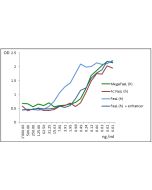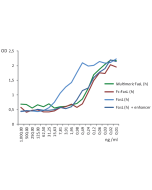Cookie Policy: This site uses cookies to improve your experience. You can find out more about our use of cookies in our Privacy Policy. By continuing to browse this site you agree to our use of cookies.
AdipoGen Life Sciences
anti-Fas (human), mAb (APO-1-1) (preservative free)

| Product Details | |
|---|---|
| Synonyms | CD95; APO-1; TNFRSF6; Tumor Necrosis Factor Receptor Superfamily Member 6; Apoptosis-mediating Surface Antigen FAS |
| Product Type | Monoclonal Antibody |
| Properties | |
| Clone | APO-1-1 |
| Isotype | Mouse IgG1 |
| Source/Host | Purified from concentrated hybridoma tissue culture supernatant. |
| Immunogen/Antigen | Recombinant human Fas. |
| Label/Conjugates | Preservative Free |
| Application |
Flow Cytometry 1-2µg/ml Note: APO-1-1 (IgG1) is an isotype-switch variant of the original clone APO-1-3 (IgG3) (Prod. No. AG-20B-0062PF). Since undesired side reactions in immunohistochemistry are minimal for IgG1 antibodies, APO-1-1 is especially useful for immunohistology on cryostat sections and on cytospin preparations. For Western Blot and Functional Applications we recommend to use anti-Fas (human), mAb (APO-1-3) (Prod. No. AG-20B-0062PF). |
| Crossreactivity | Human |
| Specificity |
Recognizes human Fas. |
| Purity | ≥95% (SDS-PAGE) |
| Concentration | 1 mg/ml. |
| Formulation | Liquid. In PBS. |
| Other Product Data |
Uniprot: Fas (human) |
| Accession Number | P25445 |
| Shipping and Handling | |
| Shipping | BLUE ICE |
| Short Term Storage | +4°C |
| Long Term Storage | -20°C |
| Handling Advice | Avoid freeze/thaw cycles. |
| Use/Stability | Stable for at least 1 year after receipt when stored at -20°C. |
| Documents | |
| MSDS |
 Download PDF Download PDF |
| Product Specification Sheet | |
| Datasheet |
 Download PDF Download PDF |
Fas (CD95) is a member of the death receptor (DR) family, a subfamily of the tumor necrosis factor receptor superfamily. The formation of the Fas death-inducing signaling complex (DISC) is the initial step of Fas signaling. Activation of procaspase-8 at the DISC leads to the induction of DR-mediated apoptosis. Stimulation of Fas has also been reported to trigger non-apoptotic pathways. It has been shown that membrane-bound FasL is essential for the cytotoxic activity, whereas soluble FasL appears to promote autoimmunity and tumorigenesis via induction of non-apoptotic pathways, in particular NF-κB.
- Monoclonal antibody-mediated tumor regression by induction of apoptosis: B.C. Trauth, et al.; Science 245, 301 (1989)
- Induction of apoptosis by monoclonal antibody anti-APO-1 class switch variants is dependent on cross-linking of APO-1 cell surface antigens: J. Dhein, et al.; J. Immunol. 149, 3166 (1992)
- Constitutive and induced expression of APO-1, a new member of the nerve growth factor/tumor necrosis factor receptor superfamily, in normal and neoplastic cells: F. Leithauser, et al.; Lab. Invest. 69, 415 (1993) (IHC Application)
- Ligand-independent redistribution of Fas (CD95) into lipid rafts mediates clonotypic T cell death: J.R. Muppidi & R.M. Siegel; Nat. Immunol. 5, 182 (2004)
- Role of CD95-mediated adipocyte loss in autoimmune lipodystrophy: P. Fischer-Posovszky, et al.; J. Clin. Endocrinol. Metab. 91, 1129 (2006)
- Cutting edge: Rac GTPases sensitize activated T cells to die via Fas: M. Ramaswamy, et al.; J. Immunol. 179, 6384 (2007)
- Low FAS/CD95 Expression by CTCL Correlates withReduced Sensitivity to Apoptosis that Can BeRestored by FAS Upregulation: J. Wu, et al.; J. Invest. Dermatol. 129, 1165 (2009) (IHC Application)
- Natural killer cells induce distinct modes of cancer cell death: Discrimination, quantification and modulation of apoptosis, necrosis and mixed forms: C.S. Backes, et al.; J. Biol. Chem. 293, 16348 (2018)
- Epigenetically Enhanced PDT Induces Significantly Higher Levels of Multiple Extrinsic Pathway Apoptotic Factors than Standard PDT, Resulting in Greater Extrinsic and Overall Apoptosis of Cutaneous T-cell Lymphoma: K.A. Salva, et al.; Photochem. Photobiol. 94, 1058 (2018) (IHC Application)







![CD95 [Fas] (human)-huIg Fusion Protein (preservative free)](https://adipogen.com/media/catalog/product/placeholder/default/adipogen_logo_bw_3.png)

